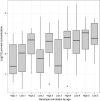Mutations in Ovis aries TMEM154 are associated with lower small ruminant lentivirus proviral concentration in one sheep flock
- PMID: 24934128
- PMCID: PMC4140605
- DOI: 10.1111/age.12181
Mutations in Ovis aries TMEM154 are associated with lower small ruminant lentivirus proviral concentration in one sheep flock
Abstract
Small ruminant lentivirus (SRLV), also called ovine progressive pneumonia virus or maedi-visna, is present in 24% of US sheep. Like human immunodeficiency virus, SRLV is a macrophage-tropic lentivirus that causes lifelong infection. The production impacts from SRLV are due to a range of disease symptoms, including pneumonia, arthritis, mastitis, body condition wasting and encephalitis. There is no cure and no effective vaccine for preventing SRLV infection. However, breed differences in prevalence and proviral concentration indicate a genetic basis for susceptibility to SRLV. Animals with high blood proviral concentration show increased tissue lesion severity, so proviral concentration represents a live animal test for control post-infection in terms of proviral replication and disease severity. Recently, it was found that sheep with two copies of TMEM154 haplotype 1 (encoding lysine at position 35) had lower odds of SRLV infection. In this study, we examined the relationship between SRLV control post-infection and variants in two genes, TMEM154 and CCR5, in four flocks containing 1403 SRLV-positive sheep. We found two copies of TMEM154 haplotype 1 were associated with lower SRLV proviral concentration in one flock (P < 0.02). This identified the same favorable diplotype for SRLV control post-infection as for odds of infection. However, frequencies of haplotypes 2 and 3 were too low in the other three flocks to test. The CCR5 promoter deletion did not have consistent association with SRLV proviral concentration. Future work in flocks with more balanced allele frequencies is needed to confirm or refute TMEM154 association with control of SRLV post-infection.
Keywords: chemokine (C-C motif) receptor 5; disease susceptibility; domestic sheep; maedi-visna virus; ovine lentivirus; ovine progressive pneumonia virus; transmembrane protein 154; viremia.
Published 2014. This article is a U.S. Government work and is in the public domain in the USA. Animal Genetics published by John Wiley & Sons Ltd on behalf of Stichting International Foundation for Animal Genetics.
Figures
References
-
- Alkhatib G, Berger EA. HIV coreceptors: from discovery and designation to new paradigms and promise. European Journal of Medical Research. 2007;12:375–84. - PubMed
-
- Annett RW, Carson AF, Dawson LE, Irwin D, Gordon AW, Kilpatrick DJ. Comparison of the longevity and lifetime performance of Scottish Blackface ewes and their crosses within hill sheep flocks. Animal: An International Journal of Animal Bioscience. 2011;5:347–55. - PubMed
-
- Arsenault J, Dubreuil P, Girard C, Simard C, Belanger D. Maedi-visna impact on productivity in Quebec sheep flocks (Canada) Preventive Veterinary Medicine. 2003;59:125–37. - PubMed
-
- Blacklaws BA. Small ruminant lentiviruses: immunopathogenesis of visna-maedi and caprine arthritis and encephalitis virus. Comparative Immunology, Microbiology, and Infectious Diseases. 2012;35:259–69. - PubMed
-
- Byun SO, Forrest RH, Frampton CM, Zhou H, Hickford JG. An association between lifespan and variation in insulin-like growth factor I receptor in sheep. Journal of Animal Science. 2012;90:2484–7. - PubMed
Publication types
MeSH terms
Substances
LinkOut - more resources
Full Text Sources
Other Literature Sources


